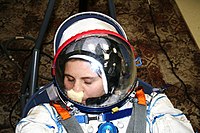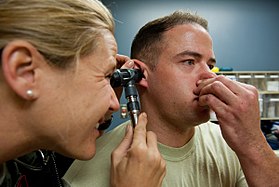|
Valsalva maneuver
The Valsalva maneuver is performed by a forceful attempt of exhalation against a closed airway, usually done by closing one's mouth and pinching one's nose shut while expelling air, as if blowing up a balloon. Variations of the maneuver can be used either in medical examination as a test of cardiac function and autonomic nervous control of the heart, or to clear the ears and sinuses (that is, to equalize pressure between them) when ambient pressure changes, as in scuba diving, hyperbaric oxygen therapy, or air travel.[1] A modified version is done by expiring against a closed glottis. This will elicit the cardiovascular responses described below but will not force air into the Eustachian tubes.[citation needed] HistoryThe technique is named after Antonio Maria Valsalva,[2][3] a 17th-century physician and anatomist from Bologna whose principal scientific interest was the human ear. He described the Eustachian tube and the maneuver to test its patency (openness). Physiological response The normal physiological response consists of four phases.[3][4]
In summary, the maneuver increases intrathoracic pressure and, thus, a decrease in preload to the heart. This decreased preload leads to cardiovascular changes through the baroreflex and other compensatory reflex mechanisms.[3] Deviation from this response pattern signifies either abnormal heart function or abnormal autonomic nervous control of the heart. Dentists also use Valsalva following extraction of a maxillary molar tooth. The maneuver is performed to determine if there is a perforation or antral communication. ApplicationsNormalizing middle-ear pressuresWhen rapid ambient pressure increase occurs, as in underwater diving or aircraft descent, this pressure tends to hold the Eustachian tubes closed, preventing pressure equalization across the eardrum and causing pain.[5][6][7] To avoid this painful situation, divers, caisson workers and people in pressurised aircraft attempt to open the Eustachian tubes by swallowing, which tends to open the tubes, allowing the ear to equalize itself.[citation needed] If this fails, then the Valsalva maneuver may be used. This maneuver, when used as a tool to equalize middle ear pressure, carries with it the risk of auditory damage from over-pressurization of the middle ear.[1][6][8] The Valsalva maneuver generates about 20–40 mm of Hg pressure.[9] It is safer, if time permits, to attempt to open the Eustachian tubes by swallowing a few times, or yawning, or by using the Valsalva technique of breathing a minimal amount of air gently into nostrils held closed by the fingers as soon as mild pressure is felt before it increases to the point that its release would be painful. The effectiveness of the "yawning" method can be improved with practice; some people can achieve release or opening by moving their jaw forward or forward and down, rather than straight down as in a classical yawn,[6] and some can do so without moving their jaw at all by activating the tensor tympani muscle, which is heard by the individual as a deep, rumbling sound. During swallowing or yawning, several muscles in the pharynx (throat) elevate the soft palate and open the throat. One of these muscles, the tensor veli palatini, also acts to open the Eustachian tube. This is why swallowing or yawning is successful in equalizing middle ear pressure. Contrary to popular belief, the jaw does not pinch the tubes shut when closed. The Eustachian tubes are not located close enough to the mandible to be pinched off. People often recommend chewing gum during ascent/descent in aircraft because chewing gum increases the rate of salivation, and swallowing the excess saliva opens the Eustachian tubes. In a clinical setting, the Valsalva maneuver is commonly done against a closed glottis or an external pressure measuring device, thus eliminating or minimizing the pressure on the Eustachian tubes. Straining or blowing against resistance, as in blowing up balloons, has a Valsalva effect, and the fall in blood pressure can result in dizziness and even fainting. Strength trainingThe Valsalva maneuver is commonly believed to be the optimal breathing pattern for producing maximal force. It is frequently used in powerlifting to stabilize the trunk during exercises such as the squat, deadlift, and bench press, and in both lifts of Olympic weightlifting.[10] Pain managementThe Valsalva maneuver can reduce pain during lumbar puncture.[11][how?] According to Kumar, et al., performing the maneuver on an awake patient triggers predictable cardiovascular and autonomic responses that can be timed by a skilled surgeon to maximize anesthetic benefit for the patient. Regulation of heart rhythmThe Valsalva maneuver may be used to arrest episodes of supraventricular tachycardia.[12][13] Blood pressure (BP) rises at onset of straining-because the increased intrathoracic pressure (ITP) is added to the pressure in the aorta. It then falls because the ITP compresses the veins, decreasing the venous return and cardiac output. This inhibits the baroreceptors, causing tachycardia and a rise in peripheral vascular resistance (PVR). When the glottis is opened and the ITP returns to normal, cardiac output is restored, but the peripheral vessels are constricted. The blood pressure therefore rises above normal, and this stimulates the baroreceptors, causing bradycardia and a drop in BP to a normal level.[14] Medical diagnosticsCardiology
The maneuver can sometimes be used to diagnose heart abnormalities, especially when used in conjunction with an echocardiogram.[15] For example, the Valsalva maneuver (phase II) increases the intensity of hypertrophic cardiomyopathy murmurs, namely those of dynamic subvalvular left ventricular outflow obstruction. This is due to the decreased preload in this phase, worsening the obstruction and thus accentuating the murmur.[3] At the same time, the Valsalva maneuver (phase II) decreases the intensity of most other murmurs, including those resulting from aortic stenosis and atrial septal defect. The decrease in murmur intensity occurs from a smaller preload, which reduces the amount of blood ejected through the stenotic aortic valve, thereby decreasing murmur intensity.[3]
NeurologyThe Valsalva maneuver is used to aid in the clinical diagnosis of problems or injuries in the nerves of the cervical spine.[16] Upon performing the Valsalva maneuver, intraspinal pressure slightly increases. Thus, neuropathies or radicular pain may be felt or exacerbated, which may indicate nerve impingement by an intervertebral disc or other part of the anatomy. Headache and pain upon performing the Valsalva maneuver are also one of the main symptoms in Arnold–Chiari malformation. The Valsalva maneuver may help check for a dural tear following certain spinal operations, such as a microdiscectomy. An increase in intra-spinal pressure will cause cerebral spinal fluid (CSF) to leak out of the dura, causing a headache.[citation needed] The Valsalva maneuver has been associated with transient global amnesia.[17][18][19][20][21] Palpation of supraclavicular lymph nodesAs the lymph nodes may be buried, asking the patient to perform the Valsalva maneuver can push the cupola of the lung upward, bringing deep-seated nodes to a more accessible position for palpation.[22] Palpation may identify an enlargement of the supraclavicular lymph nodes, a diagnostic indicator of cancer. The prevalence of malignancy in the presence of supraclavicular lymphadenopathy is reported to be in the range of 54% to 85%.[23] Oral–antral communicationA variant of the Valsalva maneuver is used to aid diagnosis of oral–antral communication, i.e., the existence of a connection between the oral cavity and the maxillary sinus.[24] Urogenital medicineThe Valsalva maneuver is used to aid in the diagnosis of intrinsic sphincteric deficiency (ISD) in urodynamic tests. Valsalva leak point pressure is the minimum vesicular pressure associated with urine leakage. Although there is no consensus on the threshold value, values > 60 cm H2O are commonly considered to indicate hypermobility of the bladder neck and normal sphincter function.[25] Also, when examining women with pelvic organ prolapse, asking the patient to perform the Valsalva maneuver is used to demonstrate maximum pelvic organ descent.[26] ComplicationsThe Valsalva maneuver is relatively safe, and side effects are rare. Yet, complications include Valsalva retinopathy in susceptible patients. There are also reports of syncope, chest pain, and arrhythmias due to the performance of the maneuver, so caution is necessary for patients with preexisting coronary artery disease, valvular heart disease, or congenital heart defects.[3] PreretinalValsalva retinopathy is pathological syndrome associated with the Valsalva maneuver.[27][28][3] It presents as preretinal hemorrhage (bleeding in front of the retina) in people with a history of transient increase in the intrathoracic pressure and may be associated with heavy lifting, forceful coughing, straining on the toilet, or vomiting. The bleeding may cause visual loss if it obstructs the visual axis, and patients may note floaters in their visual field. Usually, this causes no permanent visual impairments, and sight is fully restored. Valsalva device in spacesuits Some spacesuits contain a device called the Valsalva device to enable the wearer to block their nose to perform the Valsalva maneuver when wearing the suit. Astronaut Drew Feustel describes it as "a spongy device called a Valsalva that is typically used to block the nose in case a pressure readjustment is needed".[29] One use of the device is to equalize pressure during suit pressurization.[30] See also
References
External linksWikimedia Commons has media related to Valsalva maneuver. |
|||||||||||||||||||
